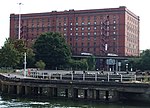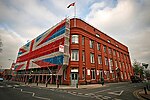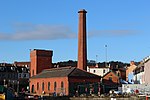Ashton Gate (stadium)
1887 establishments in EnglandAmerican football venues in EnglandBristol City F.C.English Football League venuesFootball venues in Bristol ... and 6 more
Multi-purpose stadiums in the United KingdomMusic venues in BristolRugby World Cup stadiumsRugby union stadiums in EnglandSports venues completed in 1887Use British English from April 2014

Ashton Gate is a multi-use stadium in Ashton Gate, Bristol, England, and is the home of Bristol City football club and the Bristol Bears rugby union team. Located in the south-west of the city, just south of the River Avon, it currently has an all-seated capacity of 27,000.
Excerpt from the Wikipedia article Ashton Gate (stadium) (License: CC BY-SA 3.0, Authors, Images).Ashton Gate (stadium)
Ashton Road, Bristol Ashton Gate
Geographical coordinates (GPS) Address Nearby Places Show on map
Geographical coordinates (GPS)
| Latitude | Longitude |
|---|---|
| N 51.44 ° | E -2.6202777777778 ° |
Address
Ashton Road
BS3 2EQ Bristol, Ashton Gate
England, United Kingdom
Open on Google Maps









